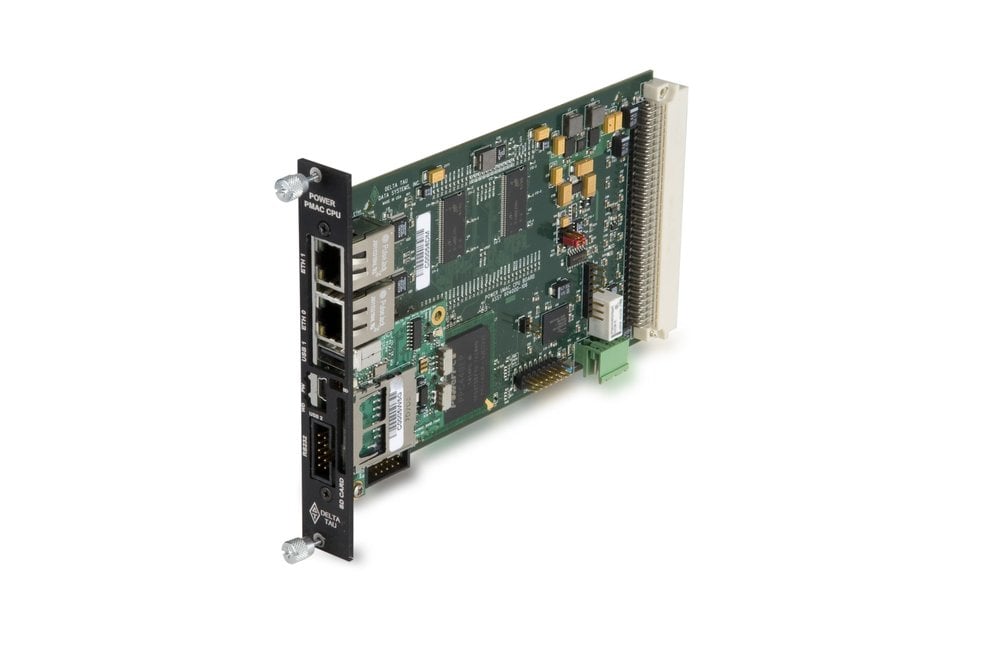www.magazine-industry-usa.com
11
'08
Written on Modified on
Power PMAC, the motion computer that provides the A to Z for going from A to B
With its ability to control up to 128 axes simultaneously, the Power PMAC is an easy-to-configure controller – whether for basic or sophisticated tasks. Thanks to a new generation of embedded Power PC microprocessors, the Power PMAC has superior computational capabilities together with a high level of peripheral integration.

The Power PMAC employs a full Linux operating system with a hard-real-time kernel, creating a complete general-purpose computing environment. But it also comes embedded with a complete motion and machine control software environment that builds on the success of Delta Tau’s existing PMAC and Turbo PMAC controllers. This results in a powerful solution for almost any commercial, industrial, or military motion control application.
It rescues machine control designers from a classic dilemma: the choice between a dedicated controller that makes executing basic tasks easy but can limit the sophistication of what can be accomplished; or a general-purpose computing engine that permits the use of the full sophistication of modern programming languages that make it very difficult just to get from Point A to Point B.
In virtually all aspects of the machine control, users have the choice between using the built-in algorithm and providing their own software, written in C or C++ and compiled with the public-domain GNU compiler. C programs can be written “manually” or generated from environments such as IEC-1131 or Matlab/SimulinkTM, as well as EPICS or other task-oriented programs.
The Power PMAC’s built-in script language for both motion sequences and general machine and I/O logic, automatically takes care of many issues that a standard language such as C does not: proper timing and pipelining of move sequences, simple or complex, automatic type matching of different variables (short-word and long-word, fixed-point and floating-point). It also provides the advanced tools of a good integrated development environment (IDE) – editors, debuggers, project managers – that standard programming languages have. It also retains the ability to issue simple “on-line” commands directly, permitting the user to “converse” easily with the controller.
The Power PMAC supports the new 3rd-generation machine-interface ASIC, which has unprecedented speed, integration, and feature set. The ASIC supports quadrature encoders with hardware 1/T interpolation, as well as sinusoidal encoders and resolvers with hardware arctangent interpolation, and most of the common serial encoder protocols such as EnDat2.2TM and SSI, plus analog, PWM, and pulse-and-direction outputs.
Some of Power PMAC’s outstanding features include:
-800 MHz and 1GHz RISC processors with hardware floating-point engine, permitting programmed move block rates of up to 5000 per second with controlled acceleration and jerk
-100-Base-T and 1000-Base T Ethernet TCP/IP communications with highly efficient DMA streaming
-PCI Express, USB, SATA, and RS-232 interfaces to support keyboard, video, disk drive, and other interfaces, making the PPMAC a complete, stand-alone RT Linux-based PC which is basically part of the system.
-Built-in web server to support direct browser access for development, maintenance, and HMI
It rescues machine control designers from a classic dilemma: the choice between a dedicated controller that makes executing basic tasks easy but can limit the sophistication of what can be accomplished; or a general-purpose computing engine that permits the use of the full sophistication of modern programming languages that make it very difficult just to get from Point A to Point B.
In virtually all aspects of the machine control, users have the choice between using the built-in algorithm and providing their own software, written in C or C++ and compiled with the public-domain GNU compiler. C programs can be written “manually” or generated from environments such as IEC-1131 or Matlab/SimulinkTM, as well as EPICS or other task-oriented programs.
The Power PMAC’s built-in script language for both motion sequences and general machine and I/O logic, automatically takes care of many issues that a standard language such as C does not: proper timing and pipelining of move sequences, simple or complex, automatic type matching of different variables (short-word and long-word, fixed-point and floating-point). It also provides the advanced tools of a good integrated development environment (IDE) – editors, debuggers, project managers – that standard programming languages have. It also retains the ability to issue simple “on-line” commands directly, permitting the user to “converse” easily with the controller.
The Power PMAC supports the new 3rd-generation machine-interface ASIC, which has unprecedented speed, integration, and feature set. The ASIC supports quadrature encoders with hardware 1/T interpolation, as well as sinusoidal encoders and resolvers with hardware arctangent interpolation, and most of the common serial encoder protocols such as EnDat2.2TM and SSI, plus analog, PWM, and pulse-and-direction outputs.
Some of Power PMAC’s outstanding features include:
-800 MHz and 1GHz RISC processors with hardware floating-point engine, permitting programmed move block rates of up to 5000 per second with controlled acceleration and jerk
-100-Base-T and 1000-Base T Ethernet TCP/IP communications with highly efficient DMA streaming
-PCI Express, USB, SATA, and RS-232 interfaces to support keyboard, video, disk drive, and other interfaces, making the PPMAC a complete, stand-alone RT Linux-based PC which is basically part of the system.
-Built-in web server to support direct browser access for development, maintenance, and HMI

